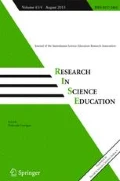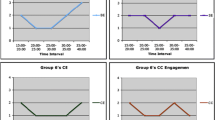Abstract
In this study we address the need to promote student engagement with school science and the need to measure a more comprehensive conception of engagement considering three dimensions of engagement: emotional, behavioural, and cognitive. We address the first issue by designing and implementing a model-based inquiry instructional sequence focused on fostering students’ engagement with science. The second issue is addressed by developing and testing a heuristic that measures student engagement holistically by focusing on all three dimensions mentioned. The results report that our short MBI instructional sequence develop students’ emotional engagement because most of them recognize to having felt interest, concentration, and satisfaction and few students reported boredom, shame, or rejection during the teaching. They spent most of the time working in small groups and sharing-discussing their hypothesis, planning and evaluating their experimental designs, and building models to explain acid-base phenomena together which highlight behavioural and cognitive dimension of students’ engagement in our instructional sequence about chewing gum and pH of the mouth. The heuristic is designed to gather data continuously during instruction with minimal disruption to the learning and teaching sequence. The heuristic can be used by teachers, researchers, and also by students, to gain multi-level understandings about engagement by focusing on individual, group-level, or class-level analysis of responses.







Similar content being viewed by others
Notes
The tasks, the phases of inquiry (boxes), and their objectives (ovals) are numbered in the cycle. Along the text, we only use these three numbers in order for the readers to identify the exact moment of the cycles with which we are referring to.
References
Antúnez, Á., Cervero, A., Solano, P., Bernardo, I., & Carbajal, R. (2017). Engagement: A new perspective for reducing dropout through self-regulation. In J. A. González-Pienda, A. Bernardo, J. C. Núñez, & C. Rodríguez (Eds.), Factors affecting academic performance (pp. 25–46). Nova Science Publishers.
Arthur, D. (2005). The effect of inquiry-based instruction on students’ participation and attitudes in a third grade science classroom. University of Central Florida.
Bellocchi, A., Quigley, C. F., & Otrel-Cass, K. (2017). Emotions, aesthetics and wellbeing in science education: Theoretical foundations. In A. Bellocchi, C. F. Quigley, & K. Otrel-Cass (Eds.), Exploring emotions, aesthetics and wellbeing in science education research (pp. 1–6). Dordrecht, The Netherlands: Springer. https://doi.org/10.1007/978-3-319-43353-0_1.
Bevins, S., & Price, G. (2016). Reconceptualising inquiry in science education. International Journal of Science Education, 38(1), 17–29. https://doi.org/10.1080/09500693.2015.1124300.
Crawford, B. A. (2014). From inquiry to scientific practices in the science classroom. In Handbook of Research on Science Education, Volume II (pp. 515–541). https://doi.org/10.4324/9780203097267.
Crujeiras-Pérez, B., & Jimenez-Aleixandre, M. P. (2017). High school students’ engagement in planning investigations: Findings from a longitudinal study in Spain. Chemical Education Research and Practice, 18(1), 99–112. https://doi.org/10.1039/C6RP00185H.
Duschl, R. A., & Grandy, R. E. (2008). Teaching scientific inquiry: Recommendations for research and implementation. Sense Publishers.
FECYT. (2019). Social perception of science and technology in Spain 2018. https://icono.fecyt.es/sites/default/files/filepublicaciones/20/percepcion_social_de_la_ciencia_y_la_tecnologia_2018_completo_0.pdf. Accessed 31 May 2021.
Fredricks, J. A., Te Wang, M., Schall Linn, J., Hofkens, T. L., Sung, H., Parr, A., & Allerton, J. (2016). Using qualitative methods to develop a survey measure of math and science engagement. Learning and Instruction, 43, 5–15. https://doi.org/10.1016/j.learninstruc.2016.01.009.
Grabau, L. J., & Ma, X. (2017). Science engagement and science achievement in the context of science instruction: A multilevel analysis of U.S. students and schools. International Journal of Science Education, 39(8), 1045–1068. https://doi.org/10.1080/09500693.2017.1313468.
Hickey, D. T., & Zuiker, S. J. (2010). Cross-cultural approaches to measuring motivation cross-cultural approaches to measuring motivation. Eduational Assessment2, 10(3), 277–305. https://doi.org/10.1207/s15326977ea1003_7.
Inkinen, J., Klager, C., Juuti, K., Schneider, B., Salmela-Aro, K., Krajcik, J., & Lavonen, J. (2020). High school students’ situational engagement associated with scientific practices in designed science learning situations. Science Education, 2018, 1–26. https://doi.org/10.1002/sce.21570.
Jeong, J. S., González-Gómez, D., & Cañada-Cañada, F. (2016). Students’ perceptions and emotions toward learning in a flipped general science classroom. Journal of Science Education and Technology, 25(5), 747–758. https://doi.org/10.1007/s10956-016-9630-8.
Jiménez-Liso, M. R., Lopez-Banet, L., & Dillon, J. (2020a). Changing how we teach acid-base chemistry: a proposal grounded in studies of the history and nature of science education. Science & Education, 29(4), 1291–1315. https://doi.org/10.1007/s11191-020-00142-6.
Jiménez-Liso, M. R., Gómez-Macario, H., Martínez-Chico, M., Garrido Espeja, A., & López-Gay, R. (2020b). Egagrópilas como fuente de pruebas en una indagación. Percepciones de los estudiantes sobre lo que aprenden y sienten. Raptor pellets as evidence in an inquiry-based teaching. Students’ perceptions on what they have learnt and felt. Revista Eureka Sobre Enseñanza y Divulgación de Las Ciencias, 17(1), 1–18. https://doi.org/10.25267/Rev.
Jiménez-Liso, M. R., Martinez Chico, M., Avraamidou, L., & López-Gay, R. (2021). Scientific practices in teacher education: the interplay of sense, sensors, and emotions. Research in Science and Technological Education, 39(1), 44–67. https://doi.org/10.1080/02635143.2019.1647158.
Lyons, T., & Quinn, F. (2010). Choosing science: Understanding the declines in senior high school science enrolments. National Centre of Science http://www.une.edu.au/simerr/pages/projects/131choosingscience.pdf.
Martínez-Chico, M., Evagorou, M., & Jiménez-Liso, M. R. (2020). Design of a pre-service teacher training unit to promote scientific practices. Is a chickpea a living being? International Journal of Designs for Learning, 11(1), 21–30. https://doi.org/10.14434/ijdl.v11i1.23757.
Milne, C., & Otieno, T. (2007). Understanding engagement: Science demonstrations and emotional energy. Science Education, 91(4), 523–553. https://doi.org/10.1002/sce20203.
Morales-Vallejo, P. (2008). La fiabilidad de los tests y escalas. The reliability of tests and scales. In P. Morales-Vallejo (Ed.), Estadistica aplicada a las Ciencias Sociales Statistics applied to the Social Sciences (pp. 3–37). Universidad Pontificia Comillas.
Mostafa, T., Echazarra, A., & Gillou, H. (2018). The science of teaching science practices in PISA 2015 (issue 188). https://doi.org/10.1787/f5bd9e57-en.
Munoz-Campos, V., Joaquin Franco-Mariscal, A., & Blanco-Lopez, A. (2018). Secondary students’ mental models about milk transformation into yogurt. Revista Eureka Sobre Enseñanza y Divulgación de Las Ciencias, 15(2), 320110–320124. https://doi.org/10.25267/Rev_Eureka_ensen_divulg_cienc.2020.v17.i3.3201.
Murphy, C., & Beggs, J. (2003). Children’s perceptions of school science a study of 8–11 year-old children indicates a progressive decline in their enjoyment of school science. School Science Review, 84(308).
Nasution, W. N. (2018). The effects of inquiry-based learning approach and emotional intelligence on students’ science achievement levels. Journal of Turkish Science Education, 15(4), 104–115. https://doi.org/10.12973/tused.10249a.
Nuffield Foundation. (2013). Model-based inquiry and practical work – An introduction How this introduction is organised Model-based inquiry and practical work – an introduction Quick start guide to model-based inquiry. https://www.stem.org.uk/resources/elibrary/resource/459821/model-based-inquiry
OECD. (2019). PISA 2018 results (volume II): Where all students can succeed. In OECD Publishing: Vol. II. https://www.oecd.org/pisa/publications/PISA2018_CN_IDN.pdf
Olitsky, S., & Milne, C. (2012). Understanding engagement in science education: The psychological and the social. In B. Fraser, K. Tobin, & C. McRobbie (Eds.), Second international handbook of science education (pp. 19–33). Springer. https://doi.org/10.1007/978-1-4020-9041-7_2.
Osborne, J. (2014). Scientific practices and inquiry in the science classroom. In N. G. Lederman (Ed.), Handbook of Research on Science Education (II ed., pp. 579–599). Lawrence Erlbaum Associates Publishers. https://doi.org/10.4324/9780203097267.ch29.
Osborne, J., & Dillon, J. (2008). Science education in Europe: Critical reflections (p. 8). Nuffield Foundation, January http://www.fisica.unina.it/traces/attachments/article/149/Nuffield-Foundation-Osborne-Dillon-Science-Education-in-Europe.pdf%5Cnpapers2://publication/uuid/FA17ED57-71AF-429E-B7E5-D9E33DA4A538.
Reeve, J. (2013). How students create motivationally supportive learning environments for themselves: The concept of agentic engagement. Journal of Educational Psychology, 105(3), 579–595. https://doi.org/10.1037/a0032690.
Riffert, F., Hagenauer, G., Kriegseisen, J., & Strahl, A. (2020). On the impact of learning cycle teaching on Austrian high school students’ emotions, academic self-concept, engagement, and achievement. Research in Science Education. https://doi.org/10.1007/s11165-020-09918-w.
Sinatra, G. M., Heddy, B. C., & Lombardi, D. (2015). The challenges of defining and measuring student engagement in science. Educational Psychologist, 50(1), 1–13. https://doi.org/10.1080/00461520.2014.1002924.
Smallhorn, M., Young, J., Hunter, N., & da Silva, K. B. (2015). Inquiry-based learning to improve student engagement in a large first year topic. Student Success, 6(2), 65–72. https://doi.org/10.5204/ssj.v6i2.292.
Tourón, J., López-González, E., Lizasoain Hernández, L., García San Pedro, M. J., & Navarro Asencio, E. (2018). Spanish high and low achievers in science in PISA 2015: Impact analysis of some contextual variables. Revista de Educacion, 2018(380). https://doi.org/10.4438/1988-592X-RE-2017-380-376.
Vázquez, Á., & Manassero, M. A. (2008). El declive de las actitudes hacia la ciencia de los estudiantes: un indicador inquietante para la educación científica. The decline in students' attitudes towards science: a disturbing indicator for science education. Revista Eureka Sobre Enseñanza y Divulgación de Las Ciencias, 8(3), 274–292. https://doi.org/10.25267/rev_eureka_ensen_divulg_cienc.2008.v5.i3.03.
Windschitl, M., Thompson, J., & Braaten, M. (2008). Beyond the scientific method: Model-based inquiry as a new paradigm of preference for school science investigations. Science Education, 92(5), 941–967.
Wittmann, S. (2011). Learning strategies and learning-related emotions among teacher trainees. Teaching and Teacher Education, 27(3), 524–532. https://doi.org/10.1016/j.tate.2010.10.006.
Wolkenhauer, R., & Hooser, A. (2017). “Inquiry is confidence”: How practitioner inquiry can support new teachers. Journal of Practitioner Research, 2(1), 5. https://doi.org/10.5038/2379-9951.2.1.1028.
Acknowledgements
Thanks to the students and teachers of the IES Murgi (El Ejido, Almeria) as well as to the teachers Lucia, Isabel, and Carmen and, also, Esteban and Yolanda from our Master Degree for their participation.
Funding
This paper is partially funded by MINECO (with FEDER funds, EDU2017-82197-P), CEIMAR-UAL, and Ministerio de Ciencia, Innovación y Universidades (PRX19/00364) of the Spain Government.
Author information
Authors and Affiliations
Contributions
M Rut Jimenez-Liso and Maria Martinez-Chico designed and implemented the instructional sequence in the IES Murgi (Secondary School in El Ejido, Almeria. Spain). Rut, Maria, and Rafael Lopez-Gay collected and analysed the data (self-report questionnaire, video recordings, students’ drawings, etc.). Alberto Bellocchi contributed to the analyses, results, conceptual framework, ensuring that evidence-based claims were made, making revisions to logical sequencing of ideas, editing manuscript drafts, and providing conceptual input to the research.
Corresponding author
Ethics declarations
Ethical Issues and Conflicts of Interest
There are no conflicts of interest, and ethical precautions were taken with the students and their parents’ consents for participation and publication.
Additional information
Publisher’s Note
Springer Nature remains neutral with regard to jurisdictional claims in published maps and institutional affiliations.
Supplementary Information
ESM 1
(DOCX 14 kb)
Rights and permissions
About this article
Cite this article
Jimenez-Liso, M.R., Bellocchi, A., Martinez-Chico, M. et al. A Model-Based Inquiry Sequence as a Heuristic to Evaluate Students’ Emotional, Behavioural, and Cognitive Engagement. Res Sci Educ 52, 1313–1334 (2022). https://doi.org/10.1007/s11165-021-10010-0
Accepted:
Published:
Issue Date:
DOI: https://doi.org/10.1007/s11165-021-10010-0




